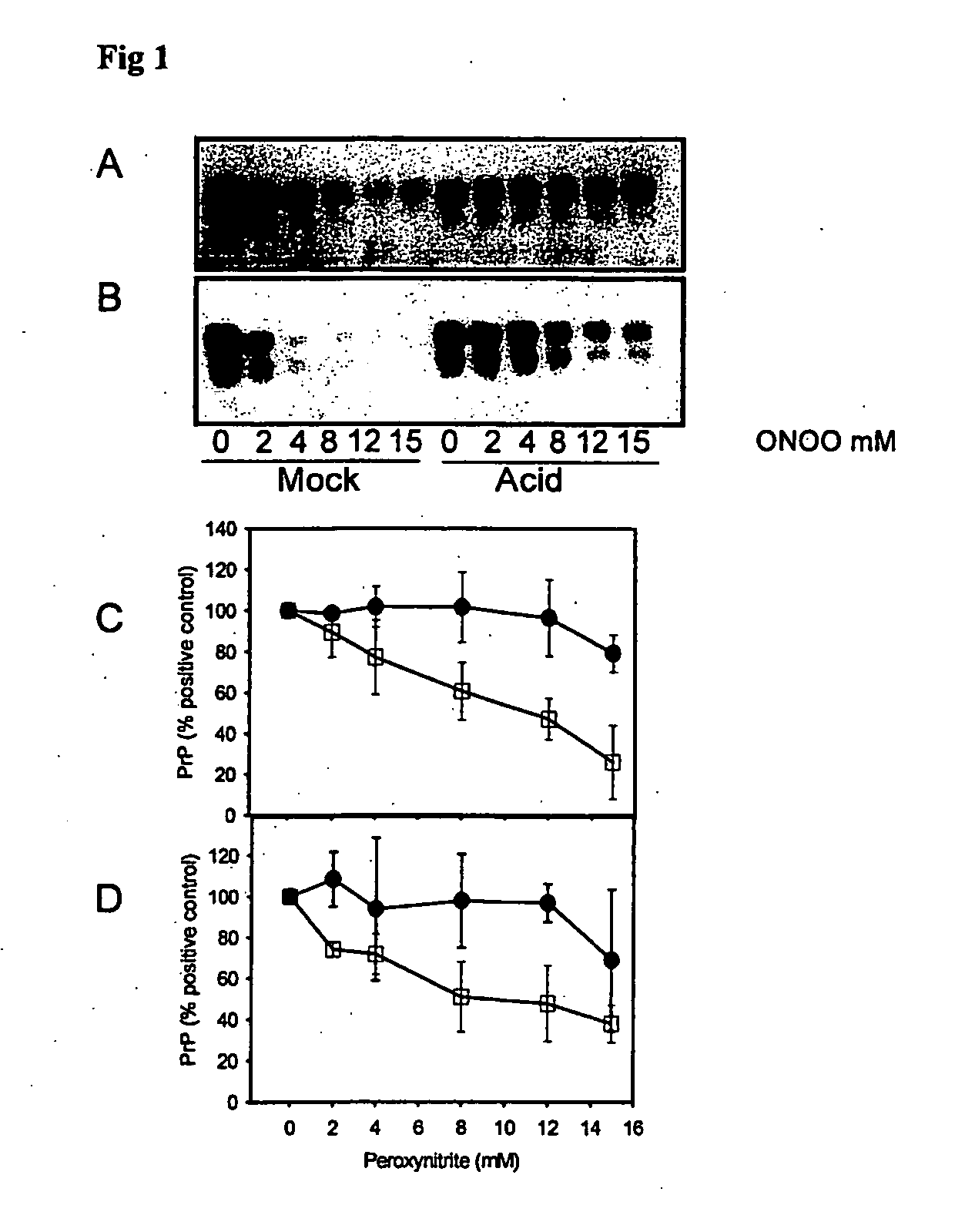Epitope protection assay
a technology of epitope and assay, applied in the field of epitope protection assay, to achieve the effect of reducing reaction and preventing or reducing reaction
- Summary
- Abstract
- Description
- Claims
- Application Information
AI Technical Summary
Benefits of technology
Problems solved by technology
Method used
Image
Examples
example 1
Peroxynitrite Reacts Differently with PrP in Normal and Acid Treated or Scrapie Brain Homogenate
[0335] When brain homogenate is incubated at pH 3.5 in the presence of guanidine, PrP becomes detergent insoluble and is more susceptible to misfolding to a PK-resistant isoform in the presence of PrPSc (29). This acid treated PrP is a ‘model prion’ which is partially misfolded and / or aggregated resembling characteristics of PrPSc. When mock (□) and acid treated (●) brain homogenate is incubated with increasing concentrations of peroxynitrite and then subjected to immunoblotting, there is less PrP recognized by both 3F4 (FIGS. 1A and C) and 6H4 (FIGS. 1B and D) in mock treated brain homogenate than in acid treated brain homogenate. The PrP in the acid treated brain homogenate is protected from modification by peroxynitrite.
example 2
PrP in Scrapie Infected Hamster Brain is Protected from Modification by Peroxynitrite
[0336] The epitope protection phenomenon for ‘model prions’ as observed in example 1 was also observed for authentic disease-misfolded prion protein in scrapie infected hamster (Ha) brain (FIGS. 2A and B). As with model prions, the 3F4 and 6H4 epitopes of PrP in HaSc brain homogenate are protected from modification by peroxynitrite. It is clear that ‘model prions’ and HaPrpsc share characteristics that provide protection from chemical modification by peroxynitrite, such as differential misfolding or aggregation.
example 3
Aggregation is Responsible for the Reduction in Peroxynitrite-Induced Epitope Modification of Misfolded PrP
[0337] To show that epitope protection of acid treated and scrapie brain was due to aggregation, samples were treated with peroxynitrite and then incubated with or without guanidine before immunoprecipitation. Treatment of the samples with guanidine dissociates aggregates of PrP (43-45) that protect the polypeptide from modification by peroxynitrite. Incubation of mock treated brain with 2.5 M guanidine after peroxynitrite treatment did not show an increase in 3F4 and 6H4 epitopes as revealed by immunoprecipitation (FIG. 3A lanes 1-4). However, when peroxynitrite-treated acid brain homogenate was incubated with guanidine, there was an increase in PrP that could be detected by immunoprecipitation with 3F4 and 6H4 immunobeads (FIG. 3A lanes 5-8). This shows that guanidine is able to dissociate aggregates of acid treated brain homogenate and release PrP that is protected from mo...
PUM
| Property | Measurement | Unit |
|---|---|---|
| pH | aaaaa | aaaaa |
| pH | aaaaa | aaaaa |
| volumes | aaaaa | aaaaa |
Abstract
Description
Claims
Application Information
 Login to View More
Login to View More - R&D
- Intellectual Property
- Life Sciences
- Materials
- Tech Scout
- Unparalleled Data Quality
- Higher Quality Content
- 60% Fewer Hallucinations
Browse by: Latest US Patents, China's latest patents, Technical Efficacy Thesaurus, Application Domain, Technology Topic, Popular Technical Reports.
© 2025 PatSnap. All rights reserved.Legal|Privacy policy|Modern Slavery Act Transparency Statement|Sitemap|About US| Contact US: help@patsnap.com



